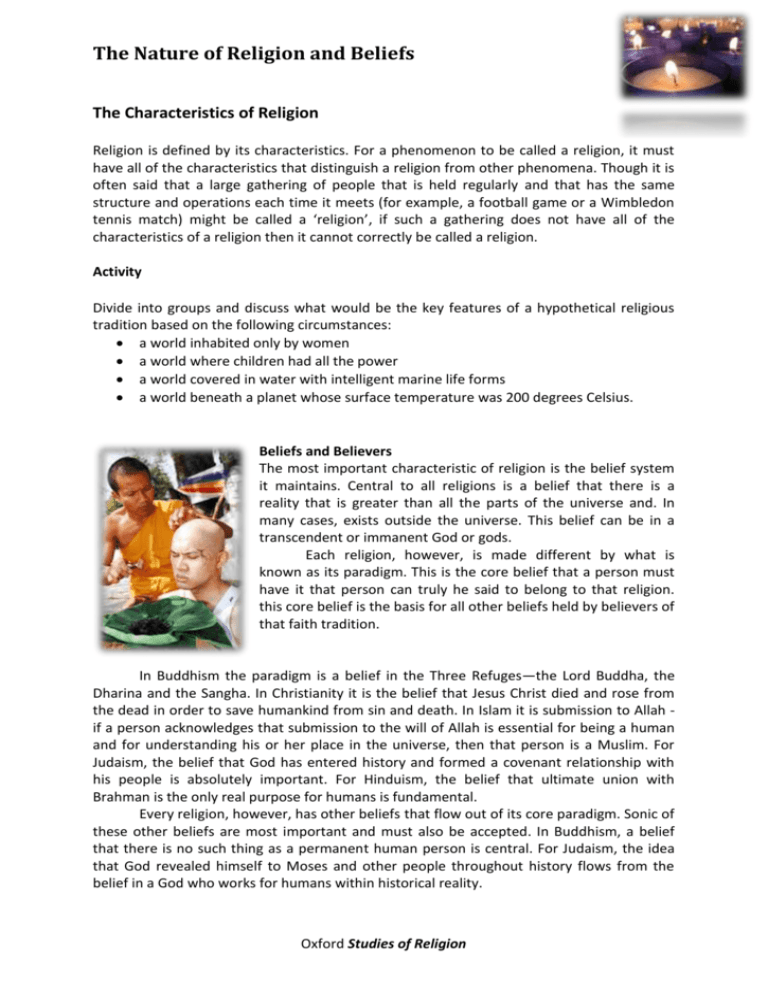2.Characteristics of Religion – Oxford
advertisement

The Nature of Religion and Beliefs The Characteristics of Religion Religion is defined by its characteristics. For a phenomenon to be called a religion, it must have all of the characteristics that distinguish a religion from other phenomena. Though it is often said that a large gathering of people that is held regularly and that has the same structure and operations each time it meets (for example, a football game or a Wimbledon tennis match) might be called a ‘religion’, if such a gathering does not have all of the characteristics of a religion then it cannot correctly be called a religion. Activity Divide into groups and discuss what would be the key features of a hypothetical religious tradition based on the following circumstances: a world inhabited only by women a world where children had all the power a world covered in water with intelligent marine life forms a world beneath a planet whose surface temperature was 200 degrees Celsius. Beliefs and Believers The most important characteristic of religion is the belief system it maintains. Central to all religions is a belief that there is a reality that is greater than all the parts of the universe and. In many cases, exists outside the universe. This belief can be in a transcendent or immanent God or gods. Each religion, however, is made different by what is known as its paradigm. This is the core belief that a person must have it that person can truly he said to belong to that religion. this core belief is the basis for all other beliefs held by believers of that faith tradition. In Buddhism the paradigm is a belief in the Three Refuges—the Lord Buddha, the Dharina and the Sangha. In Christianity it is the belief that Jesus Christ died and rose from the dead in order to save humankind from sin and death. In Islam it is submission to Allah if a person acknowledges that submission to the will of Allah is essential for being a human and for understanding his or her place in the universe, then that person is a Muslim. For Judaism, the belief that God has entered history and formed a covenant relationship with his people is absolutely important. For Hinduism, the belief that ultimate union with Brahman is the only real purpose for humans is fundamental. Every religion, however, has other beliefs that flow out of its core paradigm. Sonic of these other beliefs are most important and must also be accepted. In Buddhism, a belief that there is no such thing as a permanent human person is central. For Judaism, the idea that God revealed himself to Moses and other people throughout history flows from the belief in a God who works for humans within historical reality. Oxford Studies of Religion The Nature of Religion and Beliefs There are other beliefs that are held by sonic within a religious tradition but not by others. These beliefs are not seen to be essential for a person to belong to a particular religious tradition. For example, in Christianity there are some who believe that all God's assistance (grace) conies through Jesus' mother Mary, while other Christians would regard this belief as wrong. Both sides would still consider themselves Christian. In Buddhism, the belief of some that there are powerful beings called Bodhisattvas that can help a person attain nirvana is not universally acknowledged by other Buddhists. Both sets of believers, however, would consider themselves to be authentically Buddhist. These differing sets of belief – other than a religion's paradigm – create the various significant divisions within a religious tradition. These schools of thought or denominations have developed over time. Many have either come about through movements to reform the religious tradition by removing customs, laws and ideas that are seen as not essential for the tradition (for example, the Protestant Reformation of the sixteenth century), or they have arisen after further significant insights and understanding have developed (for example, the rise of Mahayana Buddhism). Others may form because the application of strict observance based on ancient law and custom is not thought to be relevant to modern times (for example, the rise of Liberal Judaism). There is also a range of believers within a religious tradition. It is important to acknowledge that, while there are some believers who are dedicated to the beliefs and practices – often referred to as devout believers – there are also people who are largely indifferent to the beliefs and practices and use the religion only on important occasions, for example, weddings, a boy's entry into the Sangha or a teenager's Bar Mitzvah. There are also differences in gender, age and authority structures. There are often clearly defined roles for both genders, differing expectations of young believers and more mature believers, and people possessing more authority to make decisions. There are also historic differences in practice and customs within a given religious tradition. Oxford Studies of Religion The Nature of Religion and Beliefs As a religious tradition enters into new countries and experiences, cultural differences develop within that tradition. For example, Buddhism as practised in Nepal and Tibet is different from that practised in Japan. The same is true of other religious traditions. Christianity takes different forms in South America compared with the forms in the United Kingdom. Activities 1. What is the central belief of the five major religious traditions? 2. Explain the different sets of beliefs of the major religious traditions. 3. List the reasons why beliefs are different both within a religious tradition and between religious traditions. Give examples. Oxford Studies of Religion






